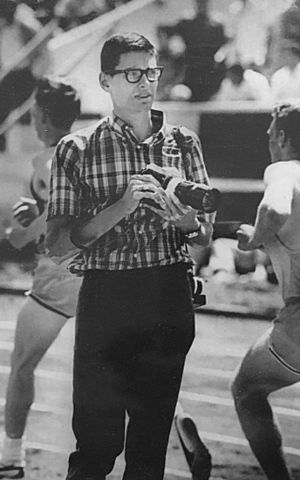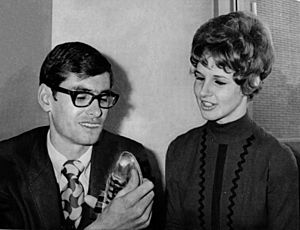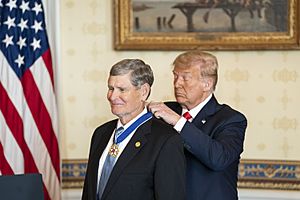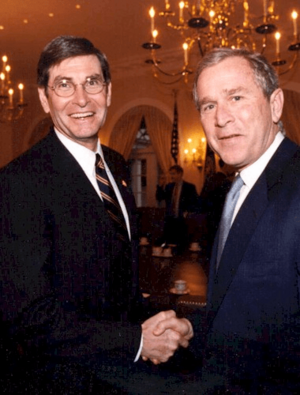Jim Ryun facts for kids
Quick facts for kids
Jim Ryun
|
||||||||||||||||||||||||||||||||||||||||
|---|---|---|---|---|---|---|---|---|---|---|---|---|---|---|---|---|---|---|---|---|---|---|---|---|---|---|---|---|---|---|---|---|---|---|---|---|---|---|---|---|
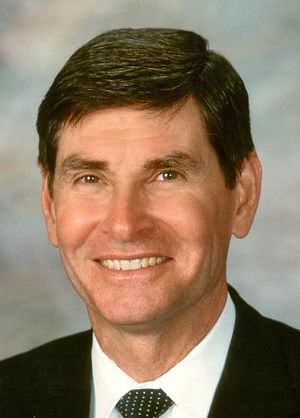 |
||||||||||||||||||||||||||||||||||||||||
| Member of the U.S. House of Representatives from Kansas's 2nd district |
||||||||||||||||||||||||||||||||||||||||
| In office November 27, 1996 – January 3, 2007 |
||||||||||||||||||||||||||||||||||||||||
| Preceded by | Sam Brownback | |||||||||||||||||||||||||||||||||||||||
| Succeeded by | Nancy Boyda | |||||||||||||||||||||||||||||||||||||||
| Personal details | ||||||||||||||||||||||||||||||||||||||||
| Born |
James Ronald Ryun
April 29, 1947 Wichita, Kansas, U.S. |
|||||||||||||||||||||||||||||||||||||||
| Political party | Republican | |||||||||||||||||||||||||||||||||||||||
| Spouse |
Anne Ryun
(m. 1969) |
|||||||||||||||||||||||||||||||||||||||
| Residence | Washington, D.C. | |||||||||||||||||||||||||||||||||||||||
| Alma mater | University of Kansas | |||||||||||||||||||||||||||||||||||||||
| Occupation | Athlete, sports management executive | |||||||||||||||||||||||||||||||||||||||
|
||||||||||||||||||||||||||||||||||||||||
James Ronald Ryun (born April 29, 1947) is an American former politician and Olympic track and field athlete. Many people considered him the world's best middle-distance runner during his peak.
He won a silver medal in the 1500-meter race at the 1968 Summer Olympics. Jim Ryun was also the first high school athlete to run a mile in under four minutes. He is the last American to hold the world record for the mile run. After his athletic career, Ryun served in the United States House of Representatives from 1996 to 2007. He represented Kansas's 2nd congressional district.
Contents
Jim Ryun's Amazing Athletic Career
Jim Ryun started running because he felt he wasn't good at other sports. He tried out for the cross-country team and found he was good at it. This was the beginning of his incredible journey in track and field.
Early Running Success in High School
In 1964, when Jim Ryun was a junior at Wichita East High School, he made history. He became the first high school athlete to run a mile in under four minutes. His time was 3:59.0.
In 1965, he set a high school record for the mile with a time of 3:55.3. This record stood for 36 years! He ran five sub-four-minute miles while still in high school. Track & Field News magazine voted him the fourth-best miler in the world. ESPN.com even named him the best high school athlete of all time.
Setting World Records After High School
In 1966, at just 19 years old, Jim Ryun set two world records. He broke records in the half-mile (1:44.9) and then the mile (3:51.3). He received many awards that year. These included Sports Illustrated magazine's "Sportsman of the Year" award. He also won the James E. Sullivan Award as the nation's top amateur athlete.
In 1967, Ryun continued to break records. He set a world record for the indoor half-mile (1:48.3). He also set a new outdoor mile record of 3:51.1, which lasted for almost eight years. That same year, he set a world record for the 1,500 meters (3:33.1).
Jim Ryun was also a champion in college. He won the NCAA outdoor mile title in 1967. He was also the NCAA indoor mile champion in 1967, 1968, and 1969.
He still holds American junior (19 and under) records for the mile (3:51.3) and two miles (8:25.1). He broke the American record for the mile four times in his career.
Olympic Games Performances
Jim Ryun competed in three Olympic Games: 1964, 1968, and 1972. In 1964, at 17 years old, he was one of the youngest American male track athletes to qualify for the Olympics.
In the 1968 Summer Olympics in Mexico City, he won a silver medal in the 1,500 meters. He lost to Kip Keino from Kenya. The race was challenging due to the high altitude in Mexico City. Ryun ran a very fast time of 3:37.8, but Keino ran even faster, setting an Olympic record. Ryun later said he felt like he had won a gold medal because he had done his very best.
At the 1972 Summer Olympics in Munich, Germany, Ryun had bad luck. He was tripped and fell during a 1,500-meter qualifying race. Even though officials agreed a foul happened, his appeals to be put back in the competition were denied. After 1972, he stopped competing as an amateur.
Jim Ryun's World Records Table
| Distance | Time | Date | City |
|---|---|---|---|
| 880 yards | 1:44.9 | June 10, 1966 | Terre Haute, IN |
| 880 yards (indoor) | 1:48.3 | 1967 | |
| 1,500 meters | 3:33.1 | July 8, 1967 | Los Angeles, CA |
| One Mile | 3:51.3 | July 17, 1966 | Berkeley, CA |
| One Mile | 3:51.1 | June 23, 1967 | Bakersfield, CA |
| One Mile (indoor) | 3:56.4 | February 19, 1971 | San Diego, CA |
- His 1,500-meter world record of 3:33.1 stood for six years.
- His one-mile world record of 3:51.1 stood for eight years.
Awards and Recognition for Athletics
- He won the Track and Field News Athlete of the Year award in both 1966 and 1967. He was the first athlete to win this award two years in a row.
- He was Sports Illustrated Sportsman of the Year in 1966. He appeared on the cover of Sports Illustrated five times.
- He received the James E. Sullivan Award in 1966. This award goes to the best amateur athlete in the U.S.
- He also won the ABC Wide World of Sports Athlete of the Year award in 1966.
In 1980, Jim Ryun was added to the National Track and Field Hall of Fame. In 2003, he was inducted into the National Distance Running Hall of Fame.
Jim Ryun's Personal Life
Jim Ryun was born in Wichita, Kansas. He now lives in Lawrence.
He met his wife, Anne, when she asked him for an autograph after he broke the world record for the mile. They married in 1969. They have two sons, Ned and Drew, and seven grandchildren. Jim, Ned, and Drew have written three books together: Heroes Among Us, The Courage to Run, and In Quest of Gold – The Jim Ryun Story.
After graduating from the University of Kansas in 1970, Ryun moved to Eugene, Oregon, and then to Santa Barbara, California, to continue his running career. In 1981, he moved back to Lawrence, Kansas.
On July 24, 2020, President Donald Trump gave Jim Ryun the Presidential Medal of Freedom. This is a very high honor given to people who have made important contributions to the United States.
Career Before Congress
Before becoming a member of the House of Representatives in 1996, Jim Ryun ran a company called Jim Ryun Sports. This company organized sports camps. He also worked as a speaker, giving motivational talks to companies and Christian groups.
Jim Ryun has a 50% hearing loss. He helped a company called ReSound Hearing Aid Company create a program. This program, called Sounds of Success, helps children with hearing loss. Since 1973, Jim Ryun and his family have hosted summer running camps for talented high school runners.
Serving in the House of Representatives
Jim Ryun became interested in politics and decided to run for Congress. He was first elected in 1996. He filled a seat that was left open by another Republican, Sam Brownback.
Elections for Congress
In 1996, Ryun won the Republican primary election. He then won the general election with 52% of the votes. For almost ten years after that, he was re-elected three times with at least 60% of the vote.
In 2004, he faced Democrat Nancy Boyda. Ryun won that election. However, in the 2006 election, Boyda ran against him again. This time, Boyda won, defeating Ryun by a margin of 51% to 47%.
In 2007, Ryun decided to run for his old seat again. He lost the Republican primary election to Lynn Jenkins. Jenkins then went on to win the seat in the general election.
Jim Ryun's Work in Congress
While in Congress, Jim Ryun served on important committees. These included the Armed Services, Budget, and Financial Services committees. He was known for having a very conservative voting record.
Ryun generally supported President George W. Bush's plans. However, he disagreed with the President on two big issues. He voted against the "No Child Left Behind" education law. He believed states should have more control over their own education systems. He also opposed a Medicare reform bill. He felt it didn't do enough to control future costs.
In 2006, the National Journal rated Jim Ryun as the most conservative member of Congress.
Environmental Record in Congress
Jim Ryun's voting record on environmental issues was often low according to some groups. In 2005, he scored 0 percent on the Republicans for Environmental Protection scorecard. This meant he did not vote in favor of any of the environmental issues they considered important. These issues included oil and natural gas drilling and protecting endangered species.
In 2006, his score improved slightly to 17%. He voted to help reduce the impact of the Army Corps of Engineers on the environment. However, he voted against issues like oil drilling in the Arctic National Wildlife Refuge.
See also
 In Spanish: Jim Ryun para niños
In Spanish: Jim Ryun para niños


